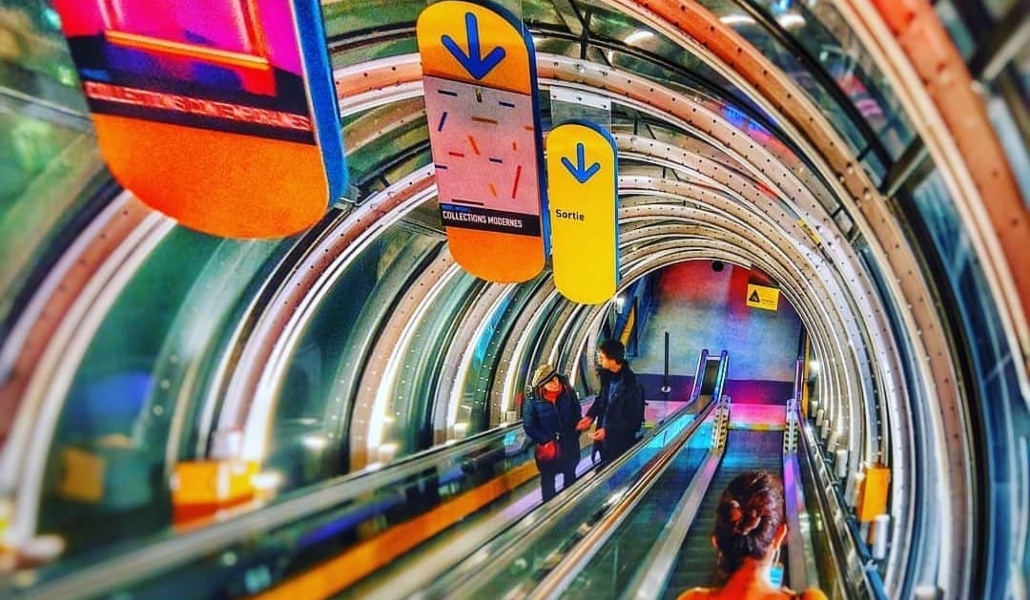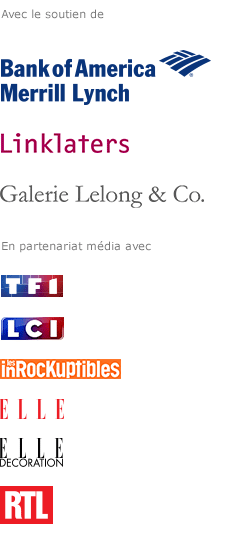Exhibition / Museum
David Hockney
19 - 23 Oct 2017

The event is over
In collaboration with London’s Tate Britain and the Metropolitan Museum of New York, the Centre Pompidou is to present the most comprehensive retrospective ever devoted to the work of David Hockney. The exhibition celebrates the artist’s 80th birthday, retracing his entire career through more than 160 works (paintings, photographs, engravings, video installations, drawings and printed works), including his most iconic paintings (swimming pools, double portraits and monumental landscapes) and some of his most recent creations.
It focuses in particular on Hockney’s interest in modern technologies for the production and reproduction of visual images. Moved by a constant concern to ensure a wide circulation for his work, he has successively taken up the camera, the fax machine, the computer, the printer,
and most recently the iPad. For him, artistic creation is an act of sharing.
The exhibition opens with paintings of Hockney’s youth, produced while at art college in his native
Bradford. Images of an industrial England, they testify to the influence of the gritty social realism of his
teachers, members of the so-called Kitchen Sink School. At the Bradford School of Art and the Royal
College of Art in London, Hockney discovered and assimilated the English take on Abstract Expressionism
represented by Alan Davie. In Jean Dubuffet he found a style (informed by graffiti, naïve art...) that
corresponded to his quest for an expressive and accessible art, and in Francis Bacon the boldness
to explicitly thematise the subject of homosexuality. His discovery of Picasso, finally, convinced him that
an artist should not limit himself to a single style: he called one of his early exhibitions Demonstrations
of Versatility.
In 1964, he discovered the West Coast of the United States, where he became the painter of a sunny
and hedonistic California, his Bigger Splash (1967) acquiring an iconic status. It was there, too, that
he embarked on the large double portraits that celebrate the realism and perspectival vision of the
photography he also assiduously engaged in. In the United States, where he now lived, Hockney was
confronted by the critical ascendancy of abstract formalism (Minimal Art, Colour Field Painting…).
To the Minimalist grid, he responded by painting building facades and geometrically mowed lawns,
and to “stain colour field painting” (which used dilute paint to stain the canvas itself) with a series
of works on paper depicting the water of a swimming pool under different lights.
In his costumes and stage designs for opera Hockney took his distance from a photographic realism
whose possibilities he now felt he had exhausted. Abandoning the classical perspective associated
with the camera (“the perspective of a paralysed Cyclops”, he once said), he experimented with
different ways of constructing space.
Looking again at Cubism, which sought to synthetically represent the vision of a viewer who moved
in relation to the subject, Hockney used a Polaroid camera to produce what he called “joiners”,
representations of the subject through multiple images joined together. Systematising this “polyfocal”
vision, he created Pearblossom Highway from more than a hundred photos taken from different points
of view. Searching for new principles for the pictorial representation of space, Hockney found inspiration
in the Chinese scroll paintings that render the visual perceptions of a viewer in movement. Combined
with the multiple viewpoints of Cubist space, this allowed him to produce Nichols Canyon, a representation
of his car journey from the city of Los Angeles to his studio in the hills.
In 1997, Hockney returned to Northern England and the countryside of his childhood. His landscapes
reflect his complex reconsideration of the question of space in painting. Using high-definition cameras,
he also brought movement to the Cubist space of his Polaroid “joiners”, juxtaposing video screens
to compose a cycle of four seasons – a subject that since the Renaissance has evoked the inexorable
passage of time.
In the 1980s, Hockney began to explore the new, digital graphics tools available for the computer,
producing new kinds of images. The computer was followed by the smartphone, and then the iPad, which
he has used to create ever more sophisticated drawings, circulated among his friends by means
of the Web.
When
11am - 11pm
11am - 9pm, every mondays, wednesdays, fridays, saturdays, sundays
11am - 11pm, every thursdays
Late night opening: Thursdays till 11 pm.
Where
Cinéma 2
Curator's point of view
Few are the 20th-century artists to have adopted Matisse’s programme of “an art of balance, of purity and serenity…rather like a good armchair.” Many there were who like Picasso made their art a field of perpetual formal invention. Even more numerous are they who like Duchamp devoted themselves to the exploration of art’s self-definition, methodically cataloguing its material components, researching the historical factors, the social conventions that contributed to defining it. The Centre Pompidou’s retrospective of the work of David Hockney celebrates an artist who has constantly questioned his style, to give agreeable form to his researches into the history of the image and the technologies employed in its production.
At the Bradford School of Art, which he joined in 1953, Hockney’s earliest works were marked by the gritty realism championed by Derek Stafford, the most notable of the Bradford teachers, a member of the so-called Kitchen Sink School, a group of English artists committed to social realism. On entering London’s Royal College of Art in 1959 he discovered the abstract painting of Alan Davie, the first English painter to take on board the lessons of the American Abstract Expressionists. Combining his interest in the work of Jean Dubuffet and Francis Bacon with his curiosity about abstraction, Hockney painted a first series of non-figurative works. The passion for “public address” that led him to his “Propaganda Paintings”, which – in still abstract idiom – championed first vegetarianism, and then, more lastingly, homosexuality, however won out against his brief flirtation with abstraction.
The Picasso retrospective at the Tate Gallery, London, in the summer of 1960 had a lasting impact on Hockney: “He [Picasso] mastered every style. The lesson I draw is that we should make use of them all”. He left the exhibition convinced that different styles or schools of painting could be for him no more than elements of a formal vocabulary in the service of subjective expression. Making profession of the stylistic eclecticism he had adopted as his programme, he grouped the four paintings he showed at the “Young Contemporaries” exhibition of 1961 under the title Demonstrations of Versatility. Pop art (Jasper Johns), colour field painting (Morris Louis), expressionist figuration (Francis Bacon), the Siennese Renaissance (Duccio di Buoninsegna) were evoked in as series of paintings that took the form of collages of styles.
Full of the idea of a hedonistic and sexually permissive California, in 1964, Hockney made his first trip to Los Angeles. To answer to the clarity and intensity of the Californian light, he adopted the acrylic paints that allowed him to create precise, intense, yet almost immaterial images. Alongside pictures from American gay magazines, he took many photographs of his own as a basis for his new paintings, some of which have the white margin typical of Polaroid photographs or picture postcards. Maintaining his dialogue with contemporary styles and painterly idioms, he gave the luminous ripples of his swimming pools the doodled forms of Jean Dubuffet’s L’Hourloupe compositions or transformed the surface into the colour field of a Mark Rothko or Barnett Newman. “Form and content are actually one… . And if you go to one extreme, what you get, I think, is a dry, arid formalism that seems a bit of a bore to me. You go to the other extreme, and you get banal illustration, which is also a bore.”
As he made greater use of photography, Hockney’s painting flirted with photorealism. In 1968, he embarked on a series of large format double portraits, haunted by Hopper, Balthus and Vermeer. Looking at Pictures on a Screen (1977) testifies to his on-going interest in the mechanical reproduction of the image for mass circulation. It shows Henry Geldzahler contemplating four reproductions of works from the National Gallery, fastened to a screen: works by Johannes Vermeer, Piero della Francesca, Vincent Van Gogh and Edgar Degas. “If a painting is truly wonderful, a reproduction, even a poor one, can communicate a good part of its magic. It’s difficult to say exactly what that is, which is why ‘magic’ is the right word. Even postcards manage to catch some of the fascination of the original,” In the mid-1960s, Hockney divided his recent paintings into two types: one concerned with formal experiment (“Technical Pictures”), the other with narrative content (“Extremely Dramatic Pictures”).
The commission for a stage design for a production of Stravinsky’s A Rake’s Progress in 1975 brought Hockney back to the theatre and its illusions. After the naturalistic phase of the double portraits, his reinterpretation of an 18th-century print opened up new horizons. Re-immersing himself in the work of William Hogarth, he discovered the frontispiece the latter had produced for a treatise on perspective. “Kerby” – the name of its publisher – became the title of a work that was a catalogue of errors of perspective.
In the early 1980s, the interest shown in his photographs by Alain Sayag, curator of photography at the Centre Pompidou, led Hockney to return to photography. Picasso once again was central to Hockney’s formal reflections. In a reworking of Cubism, he juxtaposed his pictures to represent different points of view. In this he applied to the Cubist vision the lessons he learnt from Henri Bergson (the philosopher of duration) and from popularisations of modern physics (the interconnection of space and time in relativity theory). His new paintings threw off the rules of classical perspective as Hockney, inspired by Chinese scroll paintings, records in his landscapes and interiors the successive impressions of a viewer in motion.
Hockney’s return to the landscapes of his Yorkshire childhood in 2004 prompted the artistic culmination of his interest in modern image technologies. In 2006, wanting to paint ever larger works from nature, he turned to the computer to help paint Bigger Trees Near Warter (2007), a work 4.57 m x 12.19 m in size. Only computer simulation allowed him to view everything together as he worked on the 50 different canvases that made up the work. Having developed an interest in using graphics tablets with the computer and then with the mobile phone, Hockney then employed the iPad to produce hundreds of increasingly sophisticated images. Applying to the moving image his early 1980s experiments with photographic collage (the “joiners”), Hockney created the monumental installation The Four Seasons, consisting of multiscreen images resulting from simultaneous recordings on high-definition micro-cameras. Exploiting the ability to record the successive stages in the creation of his iPad images, Hockney can now reveal his creative process in a series of images that evoke Picasso’s painting on glass, Matisse’s championing of the independent worth of different stages in his work, and the dissection of the creative process so important to Duchamp.
PERSON - Didier Ottinger
Source :
in Code Couleur, n°28, may-august 2017, pp.34-41
Partners










